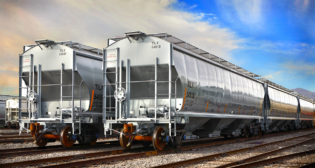
2015 freight car deliveries: 85,000
Written by William C. Vantuono, Editor-in-Chief“Demand for railcars continues to expand,” EPA’s Peter Toja notes in the analyst’s most recent quarterly freight car forecast. “Orders for 37,431 cars and platforms in the fourth quarter of 2014 far outpaced deliveries of 18,491 units, sending end-of-2014 backlogs to a record 142,837 cars. As a result, carbuilders in 2015 are starting the year with formidable levels of cars set to be assembled this year and in the foreseeable future. Equally important, with the exception of coal cars, rail equipment demand is broad-based, as both expanding traffic and replacement pressures lifted the need for a variety of car types. And, the railroads are providing significant support to equipment demand.”
EPA is projecting deliveries of 85,000 cars and platforms this year, followed by assemblies of 80,500 units in 2016. Longer term, EPA expects deliveries “to moderate at significantly high levels. After 75,800 cars are delivered in 2017, deliveries will remain at the healthy annual level of some 75,000 cars through 2020.”
North American Class I’s continue to report expanding traffic volumes, revenues, and profits. “During 2015, we look for continued high levels of commodity haulings and further growth in investments by the railroads,” Toja says.
“Our analyses of the major customer markets indicate that the investment plans are well-founded,” notes Toja. “We anticipate a modest growth in coal traffic and continued expansion in grain movements this year that will provide a major boost to rail commodity haulings. Demand for the long neglected boxcar has strengthened. After strong orders of 3,510 cars were placed in the third quarter, 800 more cars were ordered in the fourth quarter. According to industry sources, second-half orders were primarily for equipment destined for TTX. It now appears that after years of neglect, TTX is looking to upgrade its extremely aged general service cars.
“Aside from TTX, there seems to be little support from individual investors or users of boxcars. As we mentioned in previous reports, we continue to believe that the steady expansion in motor vehicle demand and production is leading to a revitalization of auto parts boxcars. However, non-automotive demand seemed quite subdued until the TTX orders.
“Demand for all types of covered hoppers continues to expand. Demand for hi-cube equipment scored an impressive gain last year. Orders for 7,250 cars far outpaced deliveries of 2,449 units, sending backlogs from 5,689 at the beginning of 2014 to 10,490 cars at the end of the year. Industry sources continue to point toward plastic pellet and chemical demand for hi-cube equipment. Corn for ethanol use has been increased as fuel consumption data indicate expanding current use and support forecast increases in demand. Due to the strength in current backlogs and the anticipation of continued growth in the corn to ethanol process, which will keep DDG demand on a high note, we look for deliveries of some 4,500 hi-cube covered hoppers this year and 5,000 cars in 2016. From 2017 through 2020, deliveries will be in the range of 4,000-4,500 cars per year.
“Given the strength in grain exports last year, orders for grain service cars rose to 11,937 units in 2014, far outpacing assemblies of 4,481 cars. As a result, backlogs at the end of the year amounted to 9,856 cars, 3.8 times above the opening-year level of 2,600 units.
“Based on higher opening year backlogs, we expect 2015 deliveries of mid-sized hoppers to amount to 5,500 cars, followed by deliveries of 6,000 units in 2016. From 2017 through 2020, deliveries will average 6,000 cars per year.
“Demand for small-cube covered hoppers continues to astound us. Full year 2014 orders amounted to 49,809 cars, far ahead of the annual assemblies of 13,402 units. As a result, carbuilders will open 2015 with unprecedented backlogs of 39,835 cars. Based on these backlogs and rising production schedules, we look for assemblies of 17,500 cars this year and 17,000 cars in 2016.
“Under relentless pressure from the Environmental Protection Agency, demand for coal cars remains subdued. Fourth-quarter 2014 orders were practically nonexistent (16 cars) and backlogs are a paltry 1,853 cars as 2015 unfolds. Continued pressure by the Obama Administration and the Environmental Protection Agency are dampening the outlook for coal consumption, production, and traffic.
“Nonetheless, there are limited bright spots for coal in the next few years. During the winter, American Electric Power pressed into service several of its older coal-burning generating units targeted for retirement in a few years, in order to comply with new federal Environmental Protection Agency rules. Indeed, a full 87% of those soon to be shuttered coal units needed to operate to help maintain electric grid reliability when the mercury plummeted across the region. Sunrise Coal has increased production capability to serve major customers such as Duke Energy Corp, Hoosier Energy (an electric cooperative in Bloomington, Ind.) Indianapolis Power and Light, and three unidentified Florida utilities.
“Based on extremely low backlogs, we expect deliveries of only 2,500 coal cars this year. Next year, we look for deliveries of 3,500 units, mostly replacements.
“Demand for intermodal equipment continues to gain momentum. After three consecutive quarterly increases, orders for articulated equipment expanded once again in the closing quarter of last year. And, in spite of a pickup in assemblies, backlogs at the end of 2014 had increased to 12,251 units, almost 15 times the beginning-year level of 825 platforms. Based on the gathering momentum in demand, we look for deliveries of 7,500 intermodal units this year and 10,000 units in 2016. Longer term, we continue to anticipate strong steady expansion in deliveries. From 12,000 units in 2017, we look for deliveries of 15,000 cars and platforms in 2020.
“Demand for non-intermodal equipment registered a good gain last year. And, fourth quarter orders of 1,575 cars far outpaced assemblies of 508 units, leaving end-of-year 2014 backlogs at 4,171 cars, far above the opening year backlogs of 1,278 units.
“Based on opening year backlogs and current production trends, we continue to look for deliveries of 3,000 Class F flats this year. Next year, we expect deliveries of 2,500 cars. The eventual recoveries in the major non-automotive customer markets will serve to keep annual Class F deliveries at about 2,500 cars per year from 2017 through 2020. Demand for tank cars continues to remain upbeat. Fourth quarter 2014 orders of 14,964 cars were the highest since the first quarter of 2013. As a result, car-builders are opening 2015 with backlogs of 57,625 cars, setting the stage for another strong year in assemblies. With the exception of three oil train mishaps in February, little has changed in the domestic oil environment.
“On the regulatory front, carbuilders are responding to the Notice of Proposed Rule Making (NPRM) on hazardous material tank cars carrying crude oil and ethanol. At issue here is the retrofitting or replacement of a number of DOT-111 tank cars as well as the most recently built CPC-1232 tank cars with enhancements to the bottom outlet value and pressure relief values that will reduce the likelihood of tank cars releasing contents in derailments. The latest estimates are that 90,000-100,000 cars currently in the fleet will be affected by increased safety regulations. Due to the rapid expansion in oil production and the lack of any significant pipeline additions, especially given the President’s recent veto of the Keystone XL Pipeline, rail will continue to benefit, and we anticipate strong annual deliveries of oil service tank cars throughout the forecast horizon.
“With railroads espousing the growth of petroleum movements, the possibility of overhauling a major portion of the fleet with newer equipment, and industry reports of expanding productive capacity among the carbuilders, we expect 2015 deliveries of 40,000 tank cars. Next year, we look for a moderation to 32,000 deliveries.



